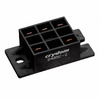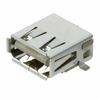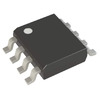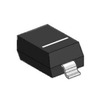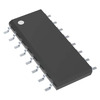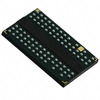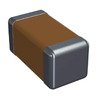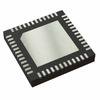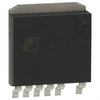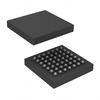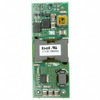1N34A Diode Guide: Key Specs, Circuit Designs, and Comparable Alternatives
The 1N34A diode stands out in the electronics world for its versatility and historical importance in low-voltage rectification and signal detection. Known for its point contact design and germanium-based structure, this diode performs exceptionally well in detecting and converting faint signals in radio frequency circuits. Its minimal forward voltage drop allows it to efficiently convert AC to DC, which was transformative in early radio technologies and remains valuable today. You can appreciate the 1N34A’s durability, sensitivity, and efficiency, making it a reliable choice across a wide range of projects, from radio receivers to TV audio detection. This article explores the diode’s construction, unique characteristics, CAD models, applications, and its continuing relevance in both vintage and modern electronic circuits.Catalog

CAD Model
Symbol

Footprint

3D Model

1N34A Diode Overview
The 1N34A diode, known for its distinct point contact configuration, is housed in a compact DO7 package and utilizes N-type Germanium. This particular design enhances the diode's effectiveness by refining its electrical properties. Germanium, celebrated for its minimal forward voltage drop and superior electron mobility, significantly contributes to the diode's precision and efficiency, especially in its specialized applications. Operating with finesse even at low voltage levels, the use of Germanium highlights its suitability in complex electronic circuits.
The diode's robust linearity and heightened efficiency make it mostly adept at handling tasks such as TV image and FM detection, as well as radio AM detection. Such applications necessitate the use of components that manage high-frequency signals with minimal distortion, a demand met successfully by the 1N34A. It is noteworthy in radio AM detection for its ability to demodulate signals with precision, ensuring clear audio output. Likewise, in FM detection, its strength lies in handling swift amplitude changes while preserving signal integrity. These attributes render it a valuable asset in both vintage and contemporary electronic configurations.
In actual applications, incorporating the 1N34A into circuits can enhance their performance due to its dependability and sensitivity. Circuits that integrate the 1N34A often exhibit enhanced signal clarity and reduced noise interference. This could be attributed to both the inherent qualities of its material and the carefully crafted design of the diode. When compared with other diodes, even minor differences in output quality highlight the unique benefits of the 1N34A. You can integrate the 1N34A into diverse projects and frequently observe its ability to maintain performance over time, indicative of its durability.
Block Diagram
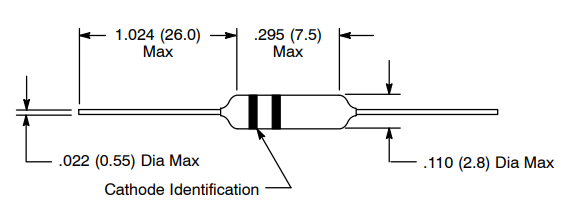
Technical Specification
Here's a structured table for the Central Semiconductor Corp 1N34A BK technical specifications, attributes, parameters, and similar parts.
|
Type |
Parameter |
|
Mounting Type |
Through Hole |
|
Package / Case |
DO-204AA, DO-7, Axial |
|
Surface Mount |
No |
|
Diode Element Material |
Germanium |
|
Number of Elements |
1 |
|
Packaging |
Bulk |
|
Published |
2016 |
|
JESD-609 Code |
e3 |
|
Pbfree Code |
Yes |
|
Part Status |
Obsolete |
|
Moisture Sensitivity Level (MSL) |
1 (Unlimited) |
|
Number of Terminations |
2 |
|
ECCN Code |
EAR99 |
|
Terminal Finish |
Matte Tin (315) |
|
HTS Code |
8541.10.00.70 |
|
Terminal Form |
Wire |
|
Peak Reflow Temperature (°C) |
260 |
|
Time @ Peak Reflow Temperature (Max) |
10 seconds |
|
JESD-30 Code |
O-PALF-W2 |
|
Qualification Status |
Not Qualified |
|
Configuration |
Single |
|
Speed |
Small Signal <= 200mA (Io), Any Speed |
|
Diode Type |
Standard |
|
Current - Reverse Leakage @ Vr |
500μA @ 50V |
|
Voltage - Forward (Vf) (Max) @ If |
1V @ 5mA |
|
Case Connection |
Isolated |
|
Operating Temperature - Junction |
-55°C to 75°C |
|
Output Current (Max) |
0.05A |
|
Voltage - DC Reverse (Vr) (Max) |
75V |
|
Current - Average Rectified (Io) |
50mA |
|
Rep Pk Reverse Voltage (Max) |
75V |
|
RoHS Status |
Non-RoHS Compliant |
Features
|
Feature |
Description |
|
Low Leakage Current |
Helps in minimizing power loss in circuits |
|
Flat Junction Capacitance |
Ensures stable performance at high frequencies |
|
High Mechanical Strength |
Offers durability and reliability in various applications |
Diverse Applications of the 1N34A
Radio Frequency Systems
The 1N34A diode plays an instrumental role in radio frequency applications, where it is prominently utilized in AM and FM detectors, ratio detectors, and FM discriminators. Its consistent performance highlights its flexibility and dependability across various scenarios. The diode's precision in demodulating signals ensures it has a notable impact on these systems. Insights from the history of radio engineering suggest that components like the 1N34A remain relevant due to their straightforward integration and enduring durability in handling signal-processing tasks.
Television Audio and Video Detection
In the world of television, the 1N34A diode showcases its effectiveness in TV audio and video detectors. By adeptly converting frequency variations into recognizable signals, it contributes significantly to television technology. This capability supports the maintenance of excellent audio and visual outputs, enhancing the viewing experience. You can consistently lean towards the 1N34A for its reliable performance under diverse conditions, offering a valuable solution to signal detection challenges in televisions.
Semiconductor Properties
The ultimate characteristics of the germanium semiconductor in the 1N34A play a basic part in its effectiveness. The low forward voltage drop intrinsic to germanium enables superior sensitivity in capturing small signals. These traits make the 1N34A especially adept for tasks requiring meticulous signal processing. Decisions in electronics design often prioritize the deliberate selection of semiconductors to boost device efficiency, thereby justifying the use of germanium in these diodes.
Circuit

Alternatives
|
Part |
Compare |
Manufacturers |
Category |
Description |
|
1N34A |
Current Part |
NTE Electronics |
Diode Switching 75V 0.05A 2Pin DO-7 |
|
|
1N34A |
1N34A VS 1N34A |
Microsemi |
Power Diodes |
Diode Switching 65V 0.05A 2Pin DO-7 |
|
1N34A-TP |
1N34A VS 1N34A-TP |
Micro Commercial Components |
Diode Switching 65V 0.05A 2Pin DO-7 T/R |
|
|
1N34 |
1N34A VS 1N34 |
Micro Commercial Components |
65V Germanium Diode |
Evolution and Uses of 1N34A Compared to 1N34
The transition from the 1N34 to the 1N34A diode illustrates a remarkable leap in semiconductor technology, mostly relevant for radio frequency applications. The 1N34A is characterized by an exceptionally low forward voltage of around 0.1 volts, greatly amplifying its performance. This innovation enhances sensitivity and efficiency, which is mostly beneficial for tasks like signal detection and RF demodulation. It serves as a practical alternative to the 1N34, especially given the current market lacks equivalent solutions.
Manufacturer
Central Semiconductor stands out in the semiconductor manufacturing landscape, renowned for its superior production quality and innovative spirit. Founded in 1974, it has continually broadened its product range. For instance, the 1N34A diode shines in high-frequency applications, offering remarkable efficiency. The company's offerings include MOSFETs, rectifiers, and other required discrete components that cater to a variety of consumer needs, displaying an acute awareness of market dynamics.
By diversifying its product line, Central Semiconductor demonstrates a strong insight into the complex requirements of the electronics industry. Its catalog features both standard and specialized components like surface mounts. bare die, and multi-discrete modules (MDMs). These products highlight the company's innovative ethos. Their versatility plays a major role in ensuring the seamless functioning of advanced electronics, often outperforming typical industry expectations. By merging reliability with contemporary design, they offer solutions that resonate with the ever-evolving demands of technology.
About us
ALLELCO LIMITED
Read more
Quick inquiry
Please send an inquiry, we will respond immediately.
Frequently Asked Questions [FAQ]
1. What is 1N34A?
The 1N34A diode, elegantly crafted in the compact DO7 package, utilizes N-form Germanium for optimal performance. Its precision in linearity and remarkable efficiency make it a standout component in signal detection. It plays a remarkable role in television and FM detection applications. The diode's responsive nature highlights its expertly crafted design, establishing it as a reliable choice for varied electronic uses.
2. What is 1N34A used for?
Appreciated for its high radiofrequency responsiveness, the 1N34A diode finds its place in AM/FM detectors, ratio detectors, and TV audio and video detecting circuits. Its allure stems from attributes like minimal leakage current and strong mechanical resilience. These features make it the go-to component in scenarios demanding clarity and signal reliability. Over time, you can recognize its consistent performance under various conditions, enhancing its worth in actual implementations.
3. Where to use 1N34A?
The Germanium 1N34A diode demonstrates its versatility across a broad spectrum of electronic devices. Radios and televisions leverage this diode effectively for swift signal processing and stabilization, becoming basic in rectification and switching operations. Through hands-on experimentation, it's evident that the diode retains its efficacy even within intricate circuitry. This versatility ensures its continued relevance, meeting the evolving needs in both traditional and modern electronic landscapes.
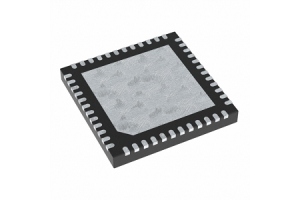
KSZ9031RNXCA: Comparison, Alternatives, and Datasheet
on November 11th
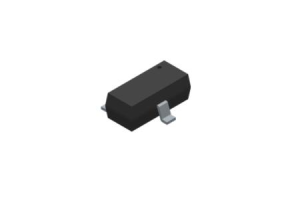
PMV65XP Trench MOSFET: Alternatives, Pinout, and Datasheet
on November 11th
Popular Posts
-

What is GND in the circuit?
on January 1th 3145
-

RJ-45 Connector Guide: RJ-45 Connector Color Codes, Wiring Schemes, R-J45 Applications, RJ-45 Datasheets
on January 1th 2697
-

Understanding Power Supply Voltages in Electronics VCC, VDD, VEE, VSS, and GND
on November 15th 2278
-

Fiber Connector Types: SC Vs LC And LC Vs MTP
on January 1th 2195
-

Comparison Between DB9 and RS232
on January 1th 1813
-

What Is An LR44 Battery?
Electricity, that ubiquitous force, quietly permeates every aspect of our daily lives, from trivial gadgets to life-threatening medical equipment, it plays a silent role. However, truly grasping this energy, especially how to store and efficiently output it, is no easy task. It is against this background that this article will focus on a type of coin cell battery that may seem insignificant on the...on January 1th 1784
-

Understanding the Fundamentals:Inductance Resistance, andCapacitance
In the intricate dance of electrical engineering, a trio of fundamental elements takes center stage: inductance, resistance, and capacitance. Each bears unique traits that dictate the dynamic rhythms of electronic circuits. Here, we embark on a journey to decipher the complexities of these components, to uncover their distinct roles and practical uses within the vast electrical orchestra. Inductan...on January 1th 1735
-

CR2430 Battery Comprehensive Guide: Specifications, Applications and Comparison to CR2032 Batteries
What is CR2430 battery ?Benefits of CR2430 BatteriesNormCR2430 Battery ApplicationsCR2430 EquivalentCR2430 VS CR2032Battery CR2430 SizeWhat to look for when buying the CR2430 and equivalentsData Sheet PDFFrequently Asked Questions Batteries are the heart of small electronic devices. Among the many types available, coin cells play a crucial role, commonly found in calculators, remote controls, and ...on January 1th 1692
-

What Is RF and Why Do We Use It?
Radio Frequency (RF) technology is a key part of modern wireless communication, enabling data transmission over long distances without physical connections. This article delves into the basics of RF, explaining how electromagnetic radiation (EMR) makes RF communication possible. We will explore the principles of EMR, the creation and control of RF signals, and their wide-ranging uses. The article ...on January 1th 1690
-

Comprehensive guide to hFE in transistors
Transistors are crucial components in modern electronic devices, enabling signal amplification and control. This article delves into the knowledge surrounding hFE, including how to select a transistor's hFE value, how to find hFE, and the gain of different types of transistors. Through our exploration of hFE, we gain a deeper understanding of how transistors work and their role in electronic circu...on November 15th 1657
